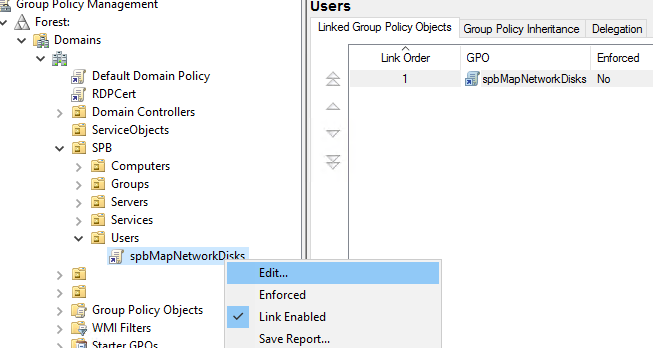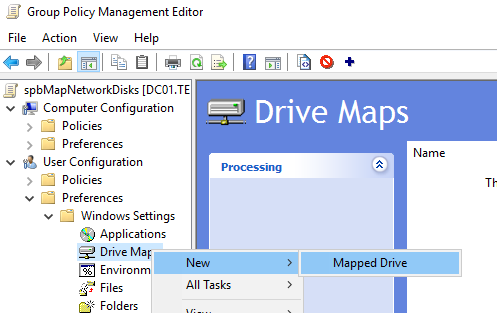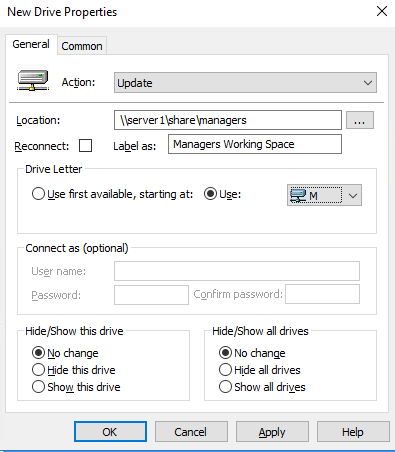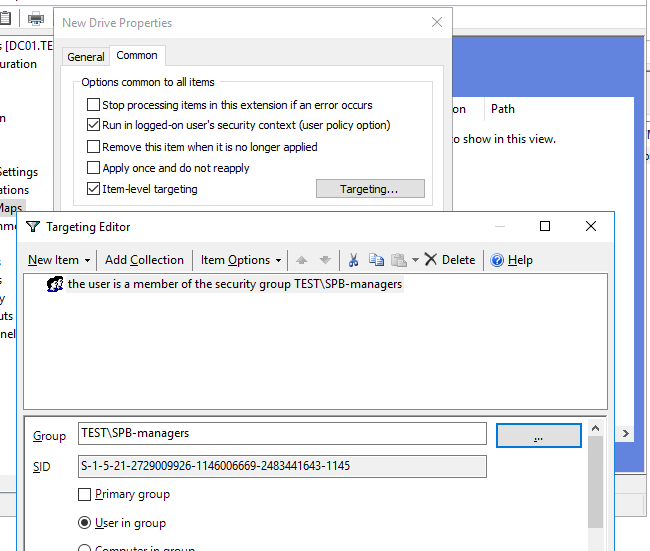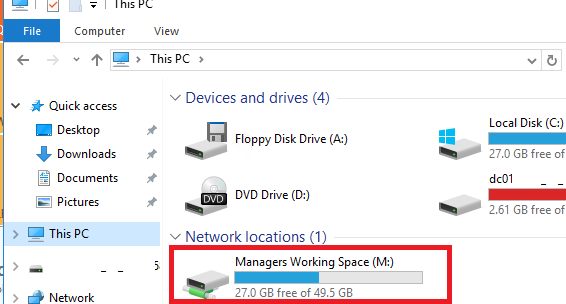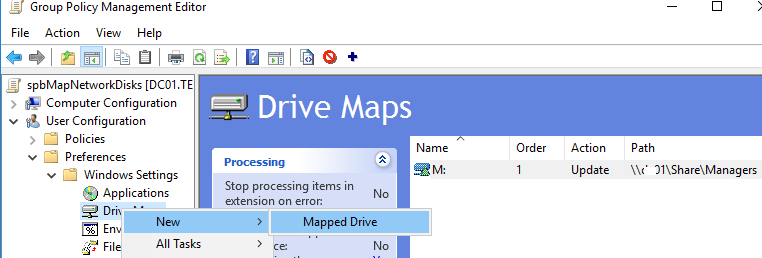Подключение сетевых дисков в Windows через групповую политику
Вы можете использовать групповые политики для гибкого подключения сетевых папок с файловых серверов в виде отдельных сетевых дисков Windows. Исторически для подключения сетевых дисков использовались логон bat скрипты с командой net use U: \\server1\share . Однако групповые политики намного гибче, отрабатывают быстрее и обновляются в фоновом режиме (не нужно выполнять перезагрузку или логоф пользователя для подключения сетевых дисков через GPO).
В этой статье мы покажем, как использовать GPO для подключения сетевых дисков в Windows: рассмотрим подключение общей сетевой папки отдела на основе групп безопасности AD и персональных сетевых дисков пользователей на сетевом хранилище.
Создайте в Active Directory новую группу для отдела менеджеров и добавьте в нее учетные записи сотрудников. Можно создать и наполнить группу из графической консоли ADUC или воспользоваться командлетами PowerShell для управления группами AD (входят в модуль AD PowerShell):
New-ADGroup «SPB-managers» -path ‘OU=Groups,OU=SPB,dc=test,DC=com’ -GroupScope Global -PassThru –Verbose
Add-AdGroupMember -Identity SPB-managers -Members a.novak, r.radojic, a.petrov, n.pavlov
Предположим, у вас есть файловый сервер, на котором хранятся общие сетевые каталоги департаментов. UNC путь к общему рабочему каталогу менеджеров, который нужно подключить всем сотрудникам отдела — \\server1\share\managers .
Теперь нужно создать GPO для подключения данного сетевого каталога в виде диска.
- Откройте консоль управления доменными GPO — Group Policy Management Console ( gpmc.msc );
- Создайте новую политику и прилинкуйте ее к OU с учетными записями пользователей, перейдите в режим редактирования политики;
- Перейдите в секцию GPO User Configuration ->Preferences ->Windows Settings ->Drive Maps. Создайте новый параметр политики New ->Mapped Drive;
- На вкладке General укажите параметры подключения сетевого диска:
-
- Action: Update (этот режим используется чаше всего);
- Location: UNC путь к каталогу, который нужно подключить;
- Label as: метка диска;
- Reconnect: сделать сетевой диск постоянным (будет переподключаться каждый раз при входе, даже если вы удалите политику – аналог параметра /persistent в net use);
- Drive Letter – назначить букву диска;
- Connect as: опция сейчас не доступна, т.к. Microsoft запретила сохранять пароли в Group Policy Preferences.
-
- Переключитесь на вкладку Common, включите опции “Run in logged on users’s security context” и “Item-level Targeting”. Затем нажмите на кнопку “Targeting”;
- Здесь мы укажем, что данная политика должна применяться только к пользователям, которые состоят в группе безопасности AD, созданной ранее. Выберите New Item ->Security Group -> укажите имя группы;
- Сохраните изменения;
- После обновления политик в сессии пользователя подключиться сетевой диск, доступный из File Explorer и других программ.
Создадим еще одно правило политики, которое подключает персональные сетевые каталоги пользователей в виде сетевых дисков. Допустим, у вас есть файловый сервер, на котором хранятся личные папки пользователей (на каждую папку назначены индивидуальные NTFS разрешения, чтобы пользователи не могли получить доступ к чужим данным). Вы хотите, чтобы эти каталоги автоматически подключались в сеанс пользователя в виде сетевых дисков.
Создайте для каждого пользователя отдельный каталог, соответствующий его имени в AD ( sAMAccountName ) и назначьте нужные NTFS права.
Создайте еще одно правило подключения дисков в той же самой GPO.
В настройках политики укажите путь к сетевому каталогу с личными папками пользователей в виде \\server1\share\home\%LogonUser% . В качестве метки диска я указал %LogonUser% — Personal .
Сохраните изменения и обновите политики на компьютерах пользователей командой:
Теперь у пользователей должны подключиться новые сетевые диски — персональные каталоги с файлового сервера. Пользователи смогут использовать их для хранения личных данных. Такой сетевой диск будет подключаться на любом компьютере, на который выполнил вход пользователь.
Таким образом в одной GPO вы можете создать множество отдельных параметров с различными условиями подключения сетевых дисков пользователям.
Для выборки различных критериев компьютеров или пользователей при подключении дисков используется функционал таргетинга GPP (в основе лежат wmi фильтры).
Group policy settings for Desktop Analytics
Applies to: Configuration Manager (current branch)
This article details the local and group policy settings in Windows that Configuration Manager and Desktop Analytics use.
When Configuration Manager enrolls devices into Desktop Analytics, it sets Windows policies to configure the device. In most circumstances, only use Configuration Manager to configure these settings.
Windows settings
Configuration Manager sets Windows policies in one or both of the following registry keys:
Group policy object (GPO): HKLM:\SOFTWARE\Policies\Microsoft\Windows\DataCollection
Local policy preference: HKLM:\SOFTWARE\Microsoft\Windows\CurrentVersion\Policies\DataCollection
| Policy | Path | Applies to | Value |
|---|---|---|---|
| CommercialId | Local | All Windows versions | In order for a device to show up in Desktop Analytics, configure it with your organization’s Commercial ID. |
| AllowTelemetry | GPO | Windows 10 | Set 1 for Basic (Required), 2 for Enhanced, or 3 for Full (Optional) diagnostic data. Desktop Analytics requires at least basic diagnostic data. Microsoft recommends that you use the Optional (limited) (Enhanced (Limited)) level with Desktop Analytics. For more information, see Configure Windows diagnostic data in your organization. |
| LimitEnhancedDiagnosticDataWindowsAnalytics | GPO | Windows 10, version 1803 and later | This setting only applies when the AllowTelemetry setting is 2 . It limits the Enhanced diagnostic data events sent to Microsoft to just those events needed by Desktop Analytics. For more information, see Windows 10 diagnostic data events and fields collected through the limit enhanced diagnostic data policy. |
| AllowDeviceNameInTelemetry | GPO | Windows 10, version 1803 and later | Enable devices to send the device name. The device name isn’t sent to Microsoft by default. If you don’t send the device name, it appears in Desktop Analytics as «Unknown». For more information, see Device name. |
| CommercialDataOptIn | Local | Windows 8.1 and earlier | Desktop Analytics requires a value of 1 . For more information, see Commercial Data Opt-in in Windows 7. |
| RequestAllAppraiserVersions | Both | Windows 8.1 and earlier | Desktop Analytics requires a value of 1 for data collection to work correctly. |
| DisableEnterpriseAuthProxy | GPO | All Windows versions | If your environment requires a user-authenticated proxy with Windows Integrated Authentication for internet access, Desktop Analytics requires a value of 0 for data collection to work correctly. For more information, see Proxy server authentication. |
When you configure the diagnostic data level, you set the upper boundary for the device. By default in Windows 10, version 1803 and later, users can choose to set a lower level. You can control this behavior using the group policy setting, Configure telemetry opt-in setting user interface.
Starting in version 2006, Configuration manager sets the following Windows policies in preparation to support an upcoming option for enterprise customers to control their Windows diagnostic data:
| Policy | Path | Applies to | Value |
|---|---|---|---|
| AllowDesktopAnalyticsProcessing | GPO | Windows 10, version 1809 and later | Desktop Analytics requires a value of 2 for data collection to work correctly. |
Starting in version 2010, Configuration Manager can configure the Optional (limited) level on the devices running Windows build version 19577 or later. For more information, see Changes to Windows diagnostic data collection. For this diagnostic data level, Configuration Manager sets the following settings:
| Policy | Value |
|---|---|
| AllowTelemetry | 3 for Optional (limited) |
| LimitDumpCollection | 1 |
| LimitDiagnosticLogCollection | 1 |
| LimitEnhancedDiagnosticDataWindowsAnalytics | 1 |
In most circumstances, only use Configuration Manager to configure these settings. Don’t also apply these settings in domain group policy objects. For more information, see Conflict resolution.
Settings from Upgrade Readiness
Windows Analytics also set the following policies through the Upgrade Readiness script:
- CommercialId
- AllowDeviceNameInTelemetry
- CommercialDataOptIn
- RequestAllAppraiserVersions
If you ran the Upgrade Readiness onboarding script on a device, these policy settings may still exist. Don’t use the legacy script. Before you enroll the device to Desktop Analytics, remove these previous policy settings.
Group policy settings
In general, use Configuration Manager collections to target Desktop Analytics settings and enrollment. Use direct membership or queries to include or exclude devices from the collection. For more information, see How to create collections.
Configuration Manager configures commercial ID and diagnostic data settings on your target collection. If you need to configure different diagnostic data settings for different group of devices, use group policy settings to override Configuration Manager settings. For example, you need to set Optional (limited) level for some devices and Required for others. Some devices may have different proxy server authentication settings.
The relevant group policy settings are at the following path: Computer Configuration > Administrative Templates > Windows Components > Data Collection and Preview Builds.
Group policy settings only modify registry settings in the following key: HKLM:\SOFTWARE\Policies\Microsoft\Windows\DataCollection
Conflict resolution
When you use group policy settings to enable complex scenarios, pay special attention to policy settings that can cause configuration conflicts. Configuration Manager only configures Windows settings if the value doesn’t already exist. Mobile device management (MDM) policies and group policy settings take precedence over Configuration Manager settings, so certain policy configurations could cause issues with Desktop Analytics. Status for devices targeted with MDM and group policy settings may not be accurately reflected in the Connection health dashboard.
The group policy settings in the following table have the greatest potential to cause conflict with the Windows settings that Configuration Manager sets on devices it enrolls to Desktop Analytics:
| Display name | Registry value | Effect on devices enrolled in Desktop Analytics |
|---|---|---|
| Configure the Commercial ID | CommercialId | If you set this policy to a different value, it overrides the Commercial ID set by Configuration Manager. If it’s not the same ID, configured devices may not appear in Desktop Analytics. |
| Allow telemetry | AllowTelemetry | If you set this policy to a different value, it overrides the global diagnostic data level that you set in Configuration Manager for the target collection. |
| Limit Enhanced diagnostic data to the minimum required by Windows Analytics | LimitEnhancedDiagnosticDataWindowsAnalytics | This policy is dependent upon the prior AllowTelemetry setting. Depending upon the level you set in Configuration Manager or with group policy, this policy can change the diagnostic data level on the device to Enhanced or Enhanced (Limited). This policy only applies if AllowTelemetry is set to 2 (Enhanced). |
| Allow device name to be sent in Windows diagnostic data | AllowDeviceNameInTelemetry | If you opt-in to send device names in Configuration Manager, you can override it by configuring this policy to Disabled. When you disable this setting, device names appear as «Unknown» in Desktop Analytics. For more information, see Device name. |
| Configure Authenticated Proxy usage for the Connected User Experience and Telemetry service | DisableEnterpriseAuthProxy | If you configure Configuration Manager devices to use user-authenticated proxy ( 0 ), if you then configure this policy to Disable Authenticated Proxy usage ( 1 ), then the device sends diagnostic data in the system context instead of the user’s context. If you don’t configure the device with a proxy in system context, or the device can’t authenticate to the proxy, Windows can’t send diagnostic data to Desktop Analytics. |
| Allow Desktop Analytics Processing | Allow Desktop Analytics Processing | If you configure this policy to Disabled ( 0 ), devices may not appear in Desktop Analytics. |
The legacy policy Configure Connected User Experiences and Telemetry (TelemetryProxy) allows Windows to forward diagnostic data to a dedicated proxy, instead of using the user (WinINET) or device (WinHTTP) proxy. Some Windows components don’t support this policy. If you use this policy, it may cause data quality issues in Desktop Analytics.
Behavior of disabled settings
If you configure these group policy settings to Disabled, it has different effects on system behavior.
When you disable the CommercialId policy, Windows removes the registry value. The Configuration Manager setting for the commercial ID, which is set in the local policy registry path, then applies to the device.
For policies that Configuration Manager sets in the same registry location as group policy, when you disable the setting in group policy, Windows removes the registry value. Configuration Manager will set it again on its next policy processing cycle, and then Windows will remove it on the next group policy refresh. This constant change in configuration may cause undesired behaviors with Desktop Analytics.
- If you set these group policy settings to Not configured, Windows removes the value once but doesn’t continue to remove it. This configuration lets Configuration Manager apply its values as expected.
Group policy settings to customize the user experience
These group policy settings aren’t required by Configuration Manager or Desktop Analytics. You can configure them in group policy to configure your users’ experience with Windows diagnostic data.
